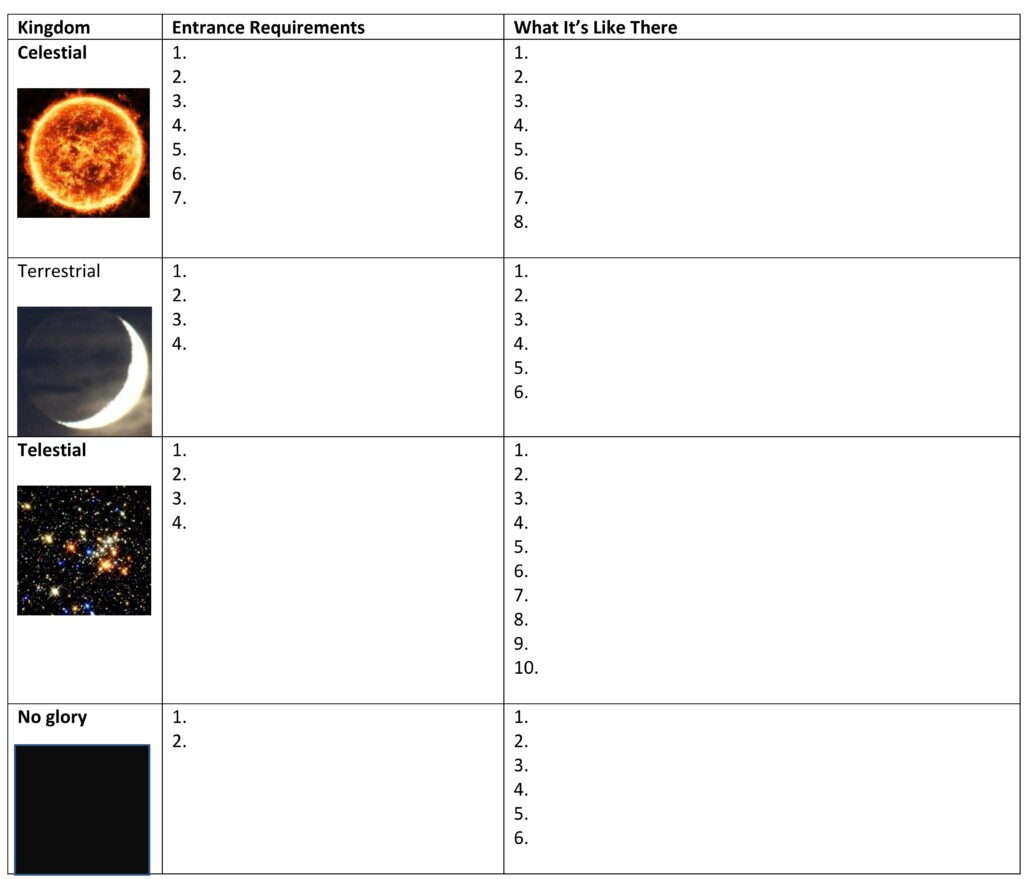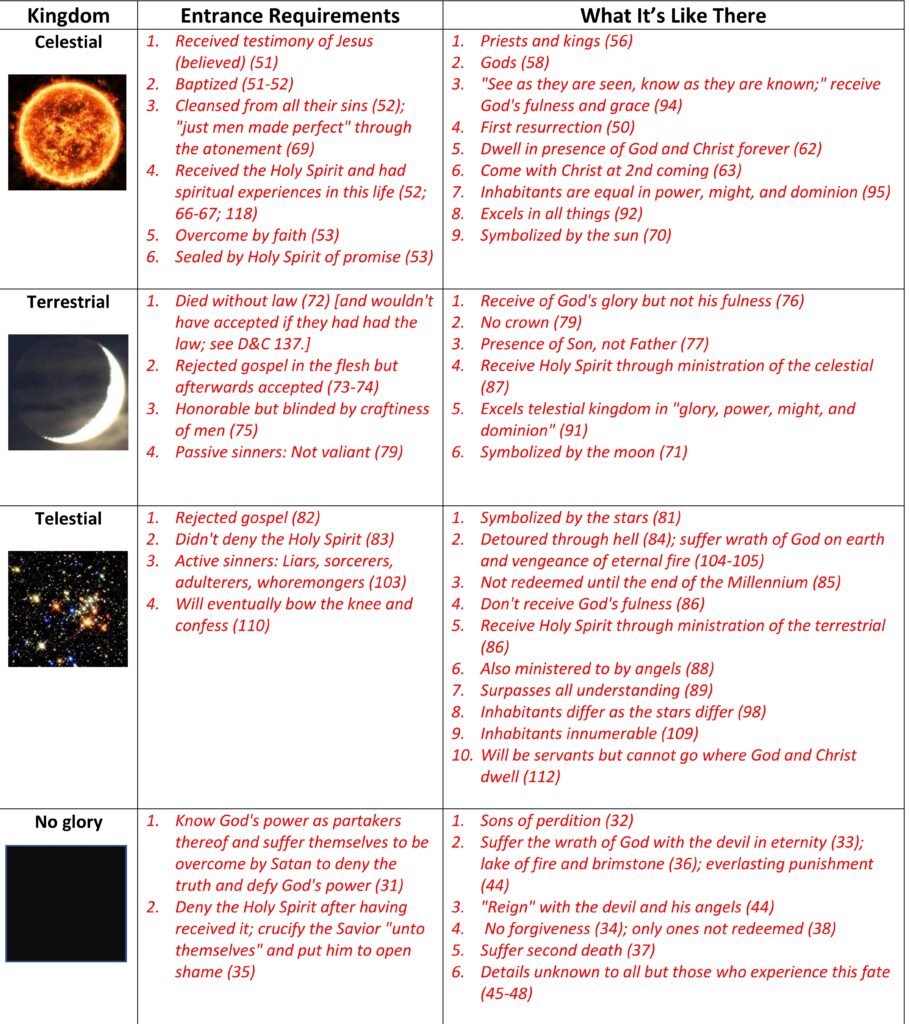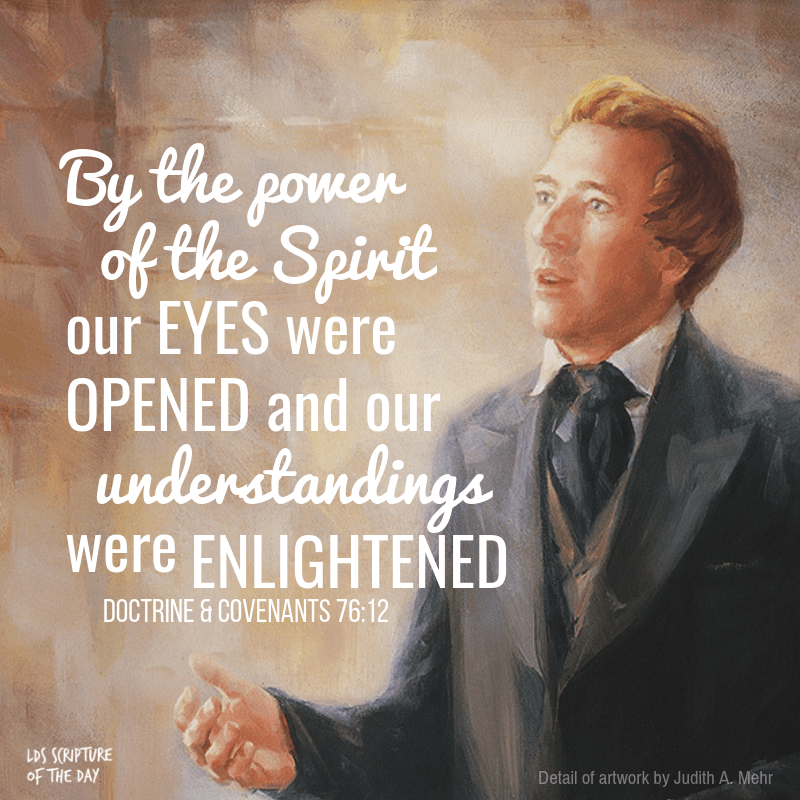To accompany your Come Follow Me study for July 7-13
In addition to reading this marvelous section and the related material in the Come Follow Me manual, you will enjoy reading:
- Chapter 27: Doctrine and Covenants 76:1–49 (churchofjesuschrist.org)
- Chapter 28: Doctrine and Covenants 76:50–119 (churchofjesuschrist.org)
- Joseph Smith’s Revelations, Doctrine and Covenants 76 (churchofjesuschrist.org)
- William W. Phelps’ introductory poem at http://mldb.byu.edu/phelps5.htm and read Joseph Smith’s reputed poetic response at https://faculty.cs.byu.edu/~clement/rel325/vision-poem.pdf. Careful literary analysis in recent years has led to the suspicion that Phelps was actually the author of the response, as well, but since it was published during Joseph Smith’s lifetime in the February 1, 1843 issue of the Times and Seasons, with no correction or rebuttal from the Prophet, we may consider it as valid prophetic commentary on the content of D&C 76.
- Saints, 1:147–50;
- “The Vision,” Revelations in Context, 148–54.
- Joseph Smith’s Bible Translation (churchofjesuschrist.org)
- https://emp.byui.edu/ANDERSONR/itc/Doctrine_and_Covenants/sections076-100/section076/76_01hundredfold_js.htm
- https://emp.byui.edu/ANDERSONR/itc/Doctrine_and_Covenants/sections076-100/section076/76_02gazeintoheaven_js.htm
- https://emp.byui.edu/ANDERSONR/itc/Doctrine_and_Covenants/sections076-100/section076/76_03sidneynotused_pd.htm
You may also enjoy the following video:
If you have the time and interest, you may even enjoy reading a paper I wrote many years ago for a graduate class at Brigham Young University entitled “Historical Development of the LDS Concept of the Three Degrees of Glory.” You can find it at: https://1drv.ms/w/s!ApUO8ho2E1yTg7M11ykQkkJdP2_kyQ?e=o6kdLW
If you would like a Kahoot game related to these sections which you could use with your family or class, click here: https://create.kahoot.it/share/doctrine-and-covenants-76/cd9294f2-f2c8-40e9-a686-697bde630e4b. To use it with a group, after clicking on this link, you will need to log into Kahoot, creating a free account if you have not done so previously, then click on the blue “Host Live” button or the gray “Assign” button, depending on how you wish to use the Kahoot. Some of the Kahoot questions may presuppose that the player has read through the suggested answers to the following Points to Ponder and at least has browsed the Institute student manual as well.
Points to Ponder in Doctrine and Covenants 76
1. What is the relationship of D&C 76 to Joseph Smith’s translation of the Bible?
2. What are the major differences between what D&C 76 reveals and what the rest of the Christian world of the time believed?
3. What in D&C 76 would have been difficult for some early Latter-day Saints to accept?
For each of the four kingdoms mentioned in D&C 76, summarize what this section tells us concerning the eligibility requirements (i.e., what you have to do to go to that kingdom) and the nature of the kingdom itself (i.e., what is it like there?) In each case, indicate the verse where the information can be found or deduced.

Possible Answers to Points to Ponder in Doctrine and Covenants 76
1. What is the relationship of D&C 76 to Joseph Smith’s translation of the Bible?
This was a direct result of Joseph’s and Sidney’s study of John 5:29, which Joseph was inspired to change slightly, leading the two to ponder on the significance of the change and to relate it to other scriptures they had studied which indicated men would be rewarded according to their works. That, in turn, suggested to them the likelihood that there had to be more kingdoms than one in the hereafter. It was while they meditated on that subject that the Lord opened their minds to the glorious vision recorded in D&C 76.
2. What are the major differences between what D&C 76 reveals and what the rest of the Christian world of the time believed?
- That there are various degrees of reward and punishment in the hereafter.
- That almost all will be saved eventually in some kingdom of glory.
- That those in the celestial kingdom can become not merely servants of God but gods in their own right.
- That there are multitudes of God’s creations in the universe which were created by the Son and for whom the Son’s atonement on this planet serves to save the inhabitants of all other worlds as well.
3. What in D&C 76 would have been difficult for some early Latter-day Saints to accept?
The biggest obstacle seems to have been that some could not accept that there would be so few consigned to eternal damnation. According to Brigham Young, “When God revealed to Joseph Smith an Sidney Rigdon that there was a place prepared for all, according to the light they had received and their rejection of evil and practice of good, it was a great trial to many, and some apostatized because God was not going to send to everlasting punishment heathens and infants, but had a place of salvation, in due time, for all, and would bless the honest and virtuous and truthful, whether they ever belonged to any church or not.” (Journal of Discourses 16:42.)
Others, presumably, could not accept the divine potential it revealed for mankind. Some Universalists may have bristled at the idea that there would be even a comparative handful of sons of perdition who would suffer eternally. Still others, no doubt, found it just too strange and radical in general, compared to what they had been taught all their lives.
For each of the four kingdoms mentioned in D&C 76, summarize what this section tells us concerning the eligibility requirements (i.e., what you have to do to go to that kingdom) and the nature of the kingdom itself (i.e., what is it like there?) In each case, indicate the verse where the information can be found or deduced.
Possible Answers to Points to Ponder in Doctrine and Covenants 76
- What is the relationship of D&C 76 to Joseph Smith’s translation of the Bible?
This was a direct result of Joseph’s and Sidney’s study of John 5:29, which Joseph was inspired to change slightly, leading the two to ponder on the significance of the change and to relate it to other scriptures they had studied which indicated men would be rewarded according to their works. That, in turn, suggested to them the likelihood that there had to be more kingdoms than one in the hereafter. It was while they meditated on that subject that the Lord opened their minds to the glorious vision recorded in D&C 76.
- What are the major differences between what D&C 76 reveals and what the rest of the Christian world of the time believed?
- That there are various degrees of reward and punishment in the hereafter.
- That almost all will be saved eventually in some kingdom of glory.
- That those in the celestial kingdom can become not merely servants of God but gods in their own right.
- That there are multitudes of God’s creations in the universe which were created by the Son and for whom the Son’s atonement on this planet serves to save the inhabitants of all other worlds as well.
- What in D&C 76 would have been difficult for some early Latter-day Saints to accept?
The biggest obstacle seems to have been that some could not accept that there would be so few consigned to eternal damnation. According to Brigham Young, “When God revealed to Joseph Smith an Sidney Rigdon that there was a place prepared for all, according to the light they had received and their rejection of evil and practice of good, it was a great trial to many, and some apostatized because God was not going to send to everlasting punishment heathens and infants, but had a place of salvation, in due time, for all, and would bless the honest and virtuous and truthful, whether they ever belonged to any church or not.” (Journal of Discourses 16:42.)
Others, presumably, could not accept the divine potential it revealed for mankind. Some Universalists may have bristled at the idea that there would be even a comparative handful of sons of perdition who would suffer eternally. Still others, no doubt, found it just too strange and radical in general, compared to what they had been taught all their lives.
For each of the four kingdoms mentioned in D&C 76, summarize what this section tells us concerning the eligibility requirements (i.e., what you have to do to go to that kingdom) and the nature of the kingdom itself (i.e., what is it like there?) In each case, indicate the verse where the information can be found or deduced.
Note: This will be a more satisfying exercise if you fill in your own answers before looking at mine. Your list could well be better!


This was a very enriching supplement to the reading, thank you, Pres!